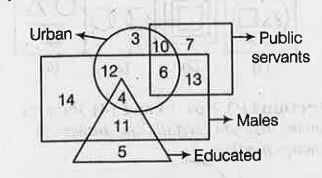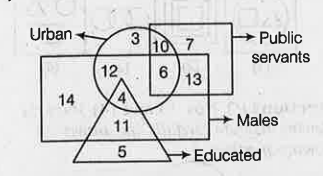Compare the life style of people living in urban areas with those of rural areas and briefly describe how the life style affects their health?
Step-by-Step Text Solution:
1. Introduction to Urban and Rural Lifestyles:
- Urban areas are characterized by a fast-paced lifestyle, high population density, and greater access to modern amenities. In contrast, rural areas typically have a slower pace of life, lower population density, and a closer connection to nature and traditional practices.
2. Food Habits:
- Urban Areas: People in urban settings often consume more fast food, such as burgers, pizzas, and processed snacks, leading to poor dietary habits. This can result in health issues like obesity, cardiovascular diseases, hypertension, and arteriosclerosis.
- Rural Areas: In contrast, individuals in rural areas tend to have diets rich in fresh vegetables and fruits, leading to better overall health and a lower incidence of obesity and related diseases.
3. Living Conditions:
- Urban Areas: Urban residents often live in crowded and sometimes unhygienic conditions. This increases their susceptibility to diseases caused by contaminated water and air, such as cholera, pneumonia, and tuberculosis.
- Rural Areas: Rural populations generally enjoy more spacious living conditions with less crowding, which reduces the spread of infectious diseases.
4. Physical Activity and Rest:
- Urban Areas: People in cities often have demanding jobs that lead to less physical activity and inadequate rest. This lifestyle contributes to obesity and related health issues.
- Rural Areas: Rural inhabitants typically engage in more physical labor as part of their daily routines, which naturally incorporates exercise into their lifestyle, helping them maintain a healthier weight.
5. Allergen Exposure:
- Urban Areas: Urban dwellers are often more prone to allergies due to their protective living environments, which limit exposure to natural allergens like pollen. This can lead to hypersensitivity and allergic reactions later in life.
- Rural Areas: In contrast, rural residents are generally more exposed to natural allergens, which may help in building a more robust immune response over time.
6. Conclusion:
- The lifestyle differences between urban and rural populations significantly impact their health. Urban residents face higher risks of lifestyle-related diseases due to poor diets, crowded living conditions, and lack of physical activity, while rural residents benefit from healthier food choices, more physical activity, and lower disease transmission rates.
---
- Urban areas are characterized by a fast-paced lifestyle, high population density, and greater access to modern amenities. In contrast, rural areas typically have a slower pace of life, lower population density, and a closer connection to nature and traditional practices.
- Urban Areas: People in urban settings often consume more fast food, such as burgers, pizzas, and processed snacks, leading to poor dietary habits. This can result in health issues like obesity, cardiovascular diseases, hypertension, and arteriosclerosis.
- Rural Areas: In contrast, individuals in rural areas tend to have diets rich in fresh vegetables and fruits, leading to better overall health and a lower incidence of obesity and related diseases.
- Urban Areas: Urban residents often live in crowded and sometimes unhygienic conditions. This increases their susceptibility to diseases caused by contaminated water and air, such as cholera, pneumonia, and tuberculosis.
- Rural Areas: Rural populations generally enjoy more spacious living conditions with less crowding, which reduces the spread of infectious diseases.
- Urban Areas: People in cities often have demanding jobs that lead to less physical activity and inadequate rest. This lifestyle contributes to obesity and related health issues.
- Rural Areas: Rural inhabitants typically engage in more physical labor as part of their daily routines, which naturally incorporates exercise into their lifestyle, helping them maintain a healthier weight.
- Urban Areas: Urban dwellers are often more prone to allergies due to their protective living environments, which limit exposure to natural allergens like pollen. This can lead to hypersensitivity and allergic reactions later in life.
- Rural Areas: In contrast, rural residents are generally more exposed to natural allergens, which may help in building a more robust immune response over time.
- The lifestyle differences between urban and rural populations significantly impact their health. Urban residents face higher risks of lifestyle-related diseases due to poor diets, crowded living conditions, and lack of physical activity, while rural residents benefit from healthier food choices, more physical activity, and lower disease transmission rates.
Topper's Solved these Questions
- HUMAN HEALTH AND DISEASESBook:MODERN PUBLICATIONChapter:HUMAN HEALTH AND DISEASESExercise:Higher Order Thinking Skills & Brain Twisting (Very Short Answer Questions)
Explore 10 Videos
- HUMAN HEALTH AND DISEASESBook:MODERN PUBLICATIONChapter:HUMAN HEALTH AND DISEASESExercise:Higher Order Thinking Skills & Brain Twisting (Short Answer Questions)
Explore 20 Videos
- HUMAN HEALTH AND DISEASESBook:MODERN PUBLICATIONChapter:HUMAN HEALTH AND DISEASESExercise:NCERT Exemplar Problems (C. SHORT ANSWER TYPE QUESTIONS)
Explore 23 Videos
- EVOLUTIONBook:MODERN PUBLICATIONChapter:EVOLUTIONExercise:CHAPTER PRACTICE TEST (SECTION-D)(CASE-BASED SHORT ANWER )(THREE MARK EACH)
Explore 2 Videos
- HUMAN REPRODUCTIONBook:MODERN PUBLICATIONChapter:HUMAN REPRODUCTIONExercise:CHAPTER PRACTICE TEST (SECTION - D LONG TYPE QUESTION)
Explore 2 Videos
Similar Questions
Knowledge Check
People in rural areas earn their living in:
AOne wayBTwo waysCAgriculture OnlyDVarious waysMost of the people in the world live in lowland areas except those in-
ACentral and Western AfricaBSouthern and South-eastern EuropeCSouthern and South-eastern AsiaDCentral America and North-western South AmericaLung diseases are about four times more probable in urban areas as compared to rural areas . This is due to the presence of which of the following in atmosphere ?
ACO2BNO2CO2DN2
Why do people migrate in large number from rural to urban areas in India?
View SolutionHow much percentage of population lives in rural and urban areas?
View SolutionIn the following figure, rectangle represents males, triangle reoresents educated people, square represents public servents and circle represents people living in urban area. Study the diagram carefully and answer the given questions.
Out of the following options, how many educated males do not live in urban area?
View SolutionIn the following figure, rectangle represents males, triangle represents educated people, square represents public servents and circle represents people living in urban area. Study the diagram carefully and answer the given questions.
Out of the following options, how many educated males are living in urban area?
View SolutionIn the following figure, rectangle represents males, triangle represents educated people, square represents public servents and circle represents people living in urban area. Study the diagram carefully and answer the given questions.
Out of the following options, how many people live in urban area who are neither public servants nor educated or males?
View Solution